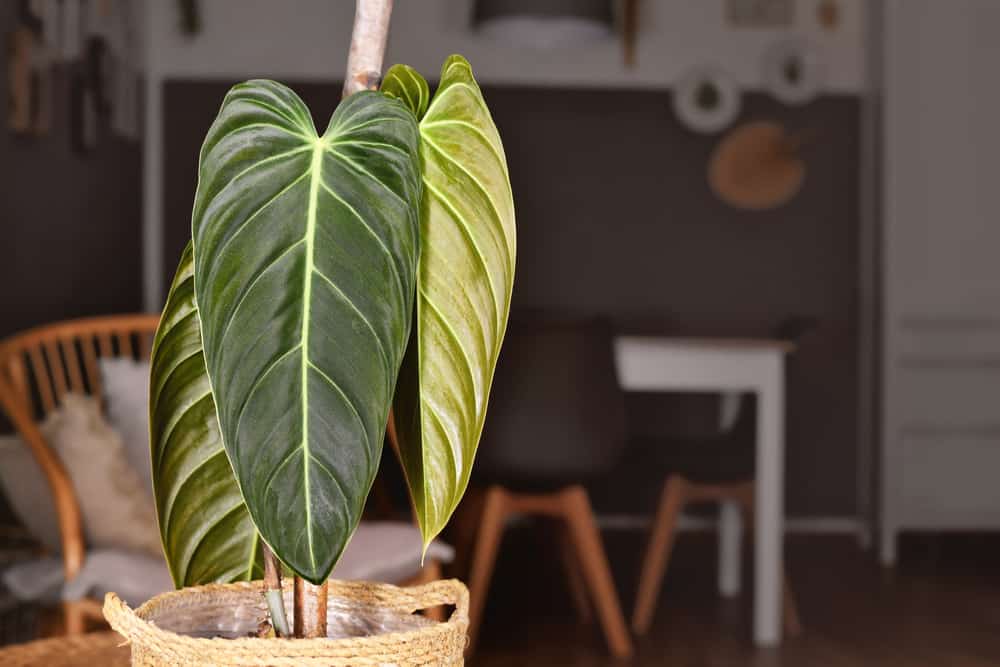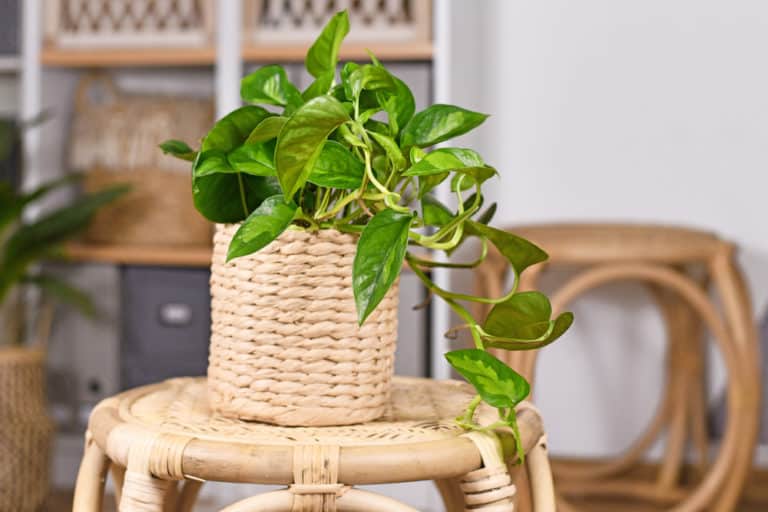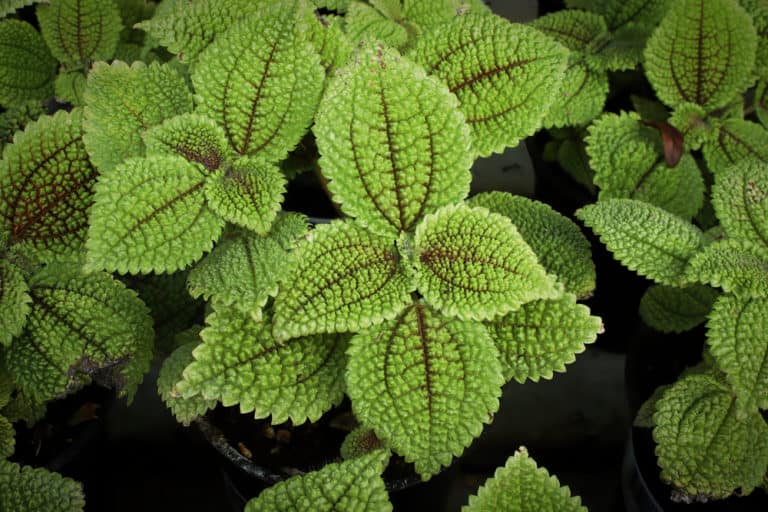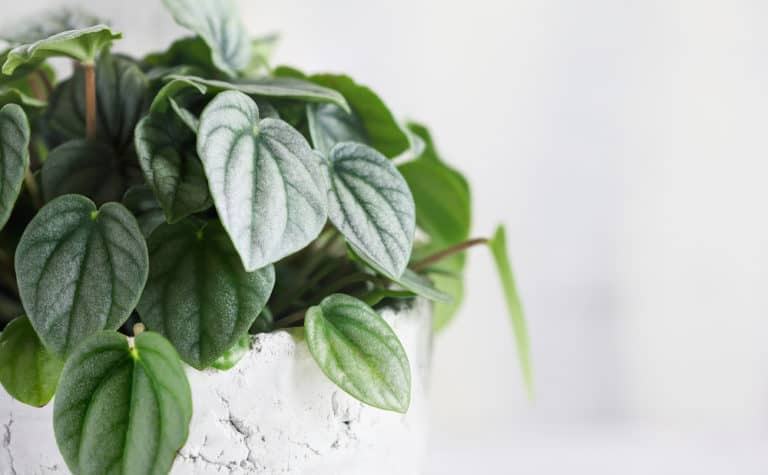Philodendron Melanochrysum ‘Melano’ Care Guide (2024)

Philodendron melanochrysum is a rare type of philodendron with a vining habit and a set of velvety dark-green foliage. The leaves can grow up to 24 inches long and have a distinctly yellow to green venation. Such attributes make the Melano plant a highly covetable green ornament – ideal for houses and gardens.
| Scientific Name | Philodendron melanochrysum |
| Common Name | Black Gold Philodendron, Melanochrysum Plant, Melano Philodendron |
| Light | Partial to moderate sunlight |
| Watering | Water if the top 2-3 inches of the soil is already dry to the touch |
| Temperature | 70 to 80°F (21-27°C) |
| Hardiness Zone | USDA Hardiness zones 9a to 11b |
| Humidity | >60% |
| Soil Type | Well-draining, high in OM |
| Soil pH | 5.5 to 6.0 (acidic) |
| Fertilizing | A balanced feed during the growing season |
| Repotting | When the plant becomes root bound |
| Pruning | Beginning of the growing season |
| Propagation | Stem cuttings |
| Toxicity | Toxic to humans and pets |
| Mature Size | Can grow up to about 18 feet in height |
| Bloom Time | Rare; Early summer |
What’s Unique About Philodendron melanochrysum?
When you have a Philodendron melanochrysum plant, you can’t be blamed if you want to display them proudly. This is because, the Melano plant features a beautiful set of dark-green crystalline foliage with a yellow venation that runs through its leaves, which also have some gold specks that are randomly distributed on the surface.
Interestingly, the Philodendron melanochrysum plants are native to Colombia but are widely distributed in Costa Rica, Peru, and the tropics of Ecuador. Owing to the look of the plant, the “melanochrysum” actually means ‘black gold’.
With their unique look and pattern, they are an ideal houseplant that can add texture and vibrance to any room and utterly dull spaces.
Philodendron melanochrysum Care
The Philodendron melanochrysum plant care involves the use of a rich and well-draining soil that is high in organic matter. Provide the plant with bright indirect light and maintain a temperature of 70-80°F. Below is more information that will give you a head start in your Melano plant care journey.
Light
Similar to most Philodendrons, the Philodendron melanochrysum light requirements are dappled or partial sunlight – as they would often grow as an understory plant in their wild habitat.
In an indoor setting, you may want to place the plant a few feet away from the window for them to receive just the right amount of light. If grown outside, you certainly want to let the plant receive some afternoon shade. Remember that full sun exposure hurts the plant’s foliage and may cause unpleasant discoloration.
If you already have some experience in growing a tropical ornamental plant, you may not have any difficulty maintaining and meeting the Melano plant light needs.
Watering
There is no fixed time when it comes to Philodendron melanochrysum watering. The best way to ensure that you are not overdoing it is by checking first the soil with your index finger. You should feel that the top 2 to 3 inches of the soil are already dry. Ideally, it takes 7 to 8 days before you can water Melano plant.
The amount of sunlight and the prevailing season also influence your plant’s watering needs. You can increase watering when it is summer and decrease it during winter. In order to prevent the occurrence of root rot, use a pot with sufficient drainage along with an appropriate potting mix.
Temperature
The Philodendron melanochrysum temperature range lies between 70 to 80°F (21-27°C). With no efficient cold temperature tolerance, it is not recommended to let the plant sit at a temperature below 60°F for this can affect their foliage formation and overall growth.
Consequently, the plant can be grown outside in USDA hardiness zones 9a to 11b. If grown indoors, exposure to cold draft must be avoided as it can still harm and cause injury to the plant.
However, when an optimum temperature for Melano plant is properly observed, you can expect the plant to grow well and thus attain its full potential.
Humidity
Considering the wild habitat from which the plant originates, it is no doubt that the Philodendron melanochrysum humidity requirements are quite high. Hence, if you are tending to this plant, you must maintain a humidity level above 60%.
Note that you should also make sure that the percent humidity will not go much higher than the optimum as this can increase the incidence of pests and diseases.
Pro tip: You can attain the ideal humidity for Melano plant with occasional misting, but setting up a pebble tray proves to be more efficient and practical. You can do this by placing the plant above a tray filled with pebbles and water.
Soil
The best Philodendron melanochrysum soil consists of an airy mix of fresh garden soil, peat moss, perlite, and charcoal. An orchid bark may be added to improve texture and drainage. You can also purchase a commercial orchid mix and use it as soil for Melano plant.
As previously mentioned, the key to avoiding overwatering is through the use of a well-draining soil mix. This will ensure that only sufficient moisture will adhere to the soil, preventing damage to the root system. Moreover, the reported ph level for Melano plant is between 5.5 to 6.0, which is quite acidic.
Fertilizer
Several reports indicate that the Philodendron melanochrysum fertilizer needs are critical in the first growth stage, or more precisely during the active growth period. Be sure to use a balanced fertilizer ratio such as NPK 20-20-20.
Avoid using cheap fertilizer for Melano plant for this tends to accumulate in the soil over time, causing toxic accumulation of minerals such as iron and aluminum. Aside from chemical fertilizers, you can also use natural amendments to boost your plant’s growth, such as biochar and vermicasts.
Pro tip: A slow-release kind of fertilizer is most often preferred by home gardeners as they tend to be more efficient and beginner-friendly.
Potting & Repotting
Ideally, Philodendron melanochrysum repotting is done when it has become rootbound or if some of the roots are already coming out of the base of the plant. Depending on the plant’s growth rate and growing environment, repotting Melano plant may take a few years.
Pro tip: Repotting is typically done in spring or summer as this enables the plant to easily adapt to the new environment. To do this, prepare a potting mix and a container that is at least twice the current pot size. Fill the pot with half of the soil and gently place the root ball in the center, fill in the remaining soil and water thoroughly.
Pruning
Philodendron melanochrysum pruning is often done only to trim off spent foliages and decaying plant parts. Hence, if you are growing it as climbing greenery, you don’t always have to prune the plant.
When cutting Melano plant, be sure to always use sterile pruning shears or knives. Cut a few stems which are about 25 % of the plant starting from the older leaves and stem. This is a good practice to get rid of any infected parts while at the same time preventing its spread among other houseplants. Also, make it a habit to wipe the leaves of your Melano plant in order to retain its healthy look and vibrance.
Propagation
The most common and perhaps most practical way of doing Philodendron melanochrysum propagation is through the use of stem cuttings.
Start by choosing a healthy stem with at least 2 to 3 small leaves and a leaf node. Cut off the stem from the mother plant using sterile scissors or a grafting knife. If you are to propagate Melano plant in water, you have to remove some of the leaves from the bottom of the cuttings but retain those at the top.
Furthermore, if you wish to let the cuttings root in the soil, you can simply plant them. Either way, you should make sure that the newly propagated plants are receiving an ample amount of light. That way, roots can take form within 3 to 4 weeks.
Also, make sure to check out our in-depth Philodendron micans care guide.
Common Problems of Philodendron melanochrysum
Some of the Philodendron melanochrysum problems that you may encounter are pests and diseases, curling, drooping, and discoloration of the leaves. These, however, are easily managed with the appropriate cultural techniques. Such as observing the proper watering cycle, avoiding overfertilization, and maintaining the right temp and humidity. Should you encounter some problems with Melano plant, below are some ways to address them.
Pests
Spider mites, scale bugs, aphids, thrips, and fungus gnats are the common problematic Philodendron melanochrysum pests, particularly if their population has not been controlled. These feeding insects can suck through the plant sap, leaving the plant lifeless because of the lack of assimilation and a disrupted nutrient flow. With continuous feeding, they can also reduce leaf area which limits the plant’s photosynthetic ability.
Pro tip: Remove insects by spraying the leaves of your Melano plant with rubbing alcohol. You may also wipe the leaves off with any debris left by insects such as honeydew, often with the use of neem oil and citronella oil.
Diseases
The most common Philodendron melanochrysum diseases are fungal and bacterial leaf spots. Other symptoms that may appear in an infected plant part are rusts, dark brown or black lesions, and yellow halos.
Overwatering causes several forms of fungal diseases in plants, hence this should be avoided. If you suspect that your Melano plant is suffering from a disease, you should check for symptoms and immediately remove the infected plant parts. You may also isolate the plant to prevent the spread of the disease.
Proper sanitation prevents the occurrence of both macro and micro pathogens. Hence, it’s important to always use sterile equipment whenever you are tending to any houseplant.
Growing Problems
In growing Philodendron melanochrysum, it is imperative to observe proper watering cycle, proper application of a balanced fertilizer, and maintaining optimum temp and humidity level. This is because the most common cause of growing problems with Melano plants is improper cultural management.
Fortunately, P. melanochrysum plants are quite resilient and can easily bounce back. However, a sick plant should be investigated for the cause in order to be treated accordingly.
Prop tip: Pruning is often the best practice to remove infected parts and revive your plant. If symptoms persist, you may opt to use fungicide but only at a minimal level.
Toxicity of Philodendron melanochrysum
Due to the calcium oxalate content of the Melano plant, it is considered toxic to humans and animals. These compounds are described as crystal-like, almost similar to shards of glass. Hence, if ingested, can cause adverse reactions as well as severe forms of irritations. This level of toxicity is quite alarming, especially for your small children.
For Humans
Calcium oxalate crystals are sharp compounds that can cause an intense burning sensation. In humans, some of the symptoms that may occur are swelling of the mouth and tongue, skin irritation, diarrhea, loss of appetite, and difficulty in breathing and swallowing.
If you have small children at home, place the plant on elevated spots, or wherever that is out of their reaches – such as bathroom windows, cabinets, and corner tables. But since children are helplessly curious, it may be better to grow the plant outside. If any of the above-mentioned symptoms occur, you should immediately seek help and call the nearest poison hotline.
For Pets
Pets like to nibble on anything that they can get a hold of, so if you have a lot of furry friends at home, it may be best to grow your Philodendron melanochrysum outside.
Some of the symptoms you should watch out for are drooling, blood in urine and stool, diarrhea, pawing of the face, loss of appetite, and restlessness. If consumed in large amounts, calcium oxalate crystals can be fatal for both cats and dogs.
If you suspect that your pet has ingested any parts of the plant, you should immediately call the vet or any of your local pet poisoning hotlines.
Philodendron melanochrysum Appearance
The Philodendron melanochrysum appearance is what makes the plant highly marketable and sought. With its lush foliage and scadent stems, the plant makes for a perfect ornamental plant that can accentuate any dull-looking spaces as well as invite that fresh jungle vibe. Below is more in-depth information regarding the Philodendron melanochrysum.
Foliage
The foliage of Philodendron melanochrysum comprises scandent and slender stems which are about 10 cm long, robust petioles that are 9 to 15 cm long, and leaf blades that expand up to about 20 cm long and 12 cm wide.
As fascinating as it looks with most philodendron species, the melano plant’s leaves are heart-shaped and elongated, with colors ranging from dark green to almost black.
In the juvenile stage, the leaves are much smaller and broader in appearance. Add to that, the velvety texture is accentuated by the gold specks and light-green venations.
If given with a moss pole or any stake, you can expect the Philodendron melanochrysum to climb over time.
Flowering
The occurrence of Philodendron melanochrysum flowering is rare in cultivation and is regarded as an unimportant feature of the plant. Some even remove the floral initials in order to concentrate the energy of the plant on foliage development.
In the wild, however, the plant may bloom. And when they do, the flowers observed are characterized as a set of inflorescence covered by a spathe and accessorized by a spadix. However, the blooms are not as spectacular as the set of dazzling foliage. The color of the Melano plant flower may range from light green to white, and the blooming period often occurs during early summer.
Size and Growth
The size of Philodendron melanochrysum plants can reach up to 26 feet, especially when they have climbing support (i.e. moss pole). The growth rate of the plant is considered slow to moderate and is said to increase at about 8 to 12 inches during the growing season.
Not happy with the growth performance of your Melano plant? You can always adjust the rate of fertilizer application, but be sure not to overdo it (read the guide above). Also, make it a habit to regularly prune the spent foliages and decaying plant parts. This way, the plant can focus its energy to efficiently increase in size and develop more leaves.
Philodendron melanochrysum Fragrance
There is little report about Philodendron melanochrysum fragrance or whether they have a scent in particular. However, there are smells that can signal a problem with your Melano plant. For example, bacterial infection can cause symptoms such as blackened soft lesions on the leaf surface, often accompanied by an unpleasant fishy odor. If this is the case, prune off immediately the infected plant parts and wipe off the leaves with alcohol or neem oil.
Root rotting, which is often caused by overwatering, can also emit strange odors from the base of the plant. Hence, it is important to maintain a proper watering cycle.
Suggested Uses for Philodendron melanochrysum
Aside from the aesthetic value that is derived from the Philodendron melanochrysum’s intricate set of foliage, you may find it equally beneficial that the large leaves also have an air-purifying property.
Indoors, you can place your Melano plant near your kitchen cabinet or even bathrooms. In fact, these areas are often very humid, which can help plant growth at an optimum.
When grown outside, the P. melanochrysum can be used as a design element for a tropical-inspired garden. Just be sure that they are not exposed to extreme cold or direct sunlight, which can cause freezing injury and leaf scorching, respectively.
FAQ
What is Philodendron melanochrysum?
The Philodendron melanochrysum is a broad-leafed plant with a vining habit and a set of velvety dark-green foliage. Its leaves can grow up to 24 inches long and have a distinctly yellow venation.
How to identify Philodendron melanochrysum?
The foliage of the Philodendron melanochrysum is heart-shaped and has a velvety texture, with colors ranging from light to dark green. It is marked with some random gold specks and a light green to yellow venation.
How to care for Philodendron melanochrysum?
In growing Philodendron melanochrysum, make sure that the plant receives ample filtered light. Use an appropriate soil mix and water when the top 2-3 inches of the soil is already dry.
How to grow Philodendron melanochrysum indoors?
Place your Melano plant a few feet from an east facing window. Maintain a temperature of 70°F and a humidity level of 60%. Water as needed.
How to grow Philodendron melanochrysum outdoors?
If grown outside, you certainly want to let the plant receive some afternoon shade. Avoid overwatering and fertilize during the active growth stage. You may place a pole behind the plant for climbing support.
How fast does Philodendron melanochrysum grow?
The Philodendron melanochrysum has a slow to moderate growth rate. You can, however, optimize the growth of your plant by proper fertilizer application and regular pruning of spent and decayed parts.
How tall does Philodendron melanochrysum grow?
In their wild habitat, the Philodendron melanochrysum can grow up to 20 feet tall. In domestication, the plant may reach a massive height if provided with climbing support.
How to make Philodendron melanochrysum grow faster?
Hasten the growth of your Melano plant by placing it on a spot that receives sufficient light. Use a balanced fertilizer and regularly prune spent foliages to support development.
How to stake Philodendron melanochrysum?
Place a stake or moss pole behind your Philodendron melanochrysum, sometimes you can even tie your plant so it will eventually cling onto the stake.
How to pot Philodendron melanochrysum?
Prepare a potting mix and a container with sufficient drainage. Fill the pot with half of the soil and gently place the root ball in the center, fill in the remaining soil and water thoroughly.
How to revive Philodendron melanochrysum?
Revive your Philodendron melanochrysum by pruning off dead stems and leaves. Be sure to provide adequate water and feed the plant as needed.
Why is my Philodendron melanochrysum dying?
A dying Philodendron melanochrysum may either be caused by improper cultural management or feeding insects and pathogens. Investigate first for the cause and treat your plant accordingly.
Why is my Philodendron melanochrysum drooping?
Drooping leaves may be attributed to overwatering. The lack of oxygen due to oversaturation can disrupt the flow of assimilates and nutrient elements from the soil absorbed through the roots and transported to the leaves.
How cold can Philodendron melanochrysum tolerate?
It is not recommended to let the Melano plant sit at a temperature below 60°F as this can affect its foliage formation and overall growth.
How to get rid of pests on Philodendron melanochrysum?
Get rid of pests by directly spraying alcohol on your Philodendron melanochrysum. It’s also a good practice to regularly wipe the leaves to remove any debris, such as honeydew, which can further attract feeding insects.
Is Philodendron melanochrysum toxic to cats?
Yes, Philodendron melanochrysum are toxic to cats because they contain calcium oxalate crystals that can cause adverse reactions if ingested. Symptoms may include pawing of the face and restlessness.
Is Philodendron melanochrysum toxic to dogs?
Yes, the Philodendron melanochrysum is toxic to dogs. This is due to the calcium oxalate crystals that if ingested can cause adverse reactions such as swelling of the mouth, urine in the blood, and difficulty eating.
Is Philodendron melanochrysum toxic to children?
Yes, the Philodendron melanochrysum are toxic to small children. Calcium oxalates found in the plant can cause diarrhea, skin irritation, difficulty breathing and difficulty swallowing.
Is Philodendron melanochrysum toxic to humans?
Yes. Calcium oxalate crystals found in the plant, if ingested in large amounts, can cause serious medical issues. Some symptoms include vomiting, diarrhea, mouth blisters, and loss of appetite.
Does Philodendron melanochrysum have a scent?
There is little information about Philodendron melanochrysum fragrance or scent. However, certain odors can be a signal that your plant may be suffering from a disease like bacterial and fungal infections.






